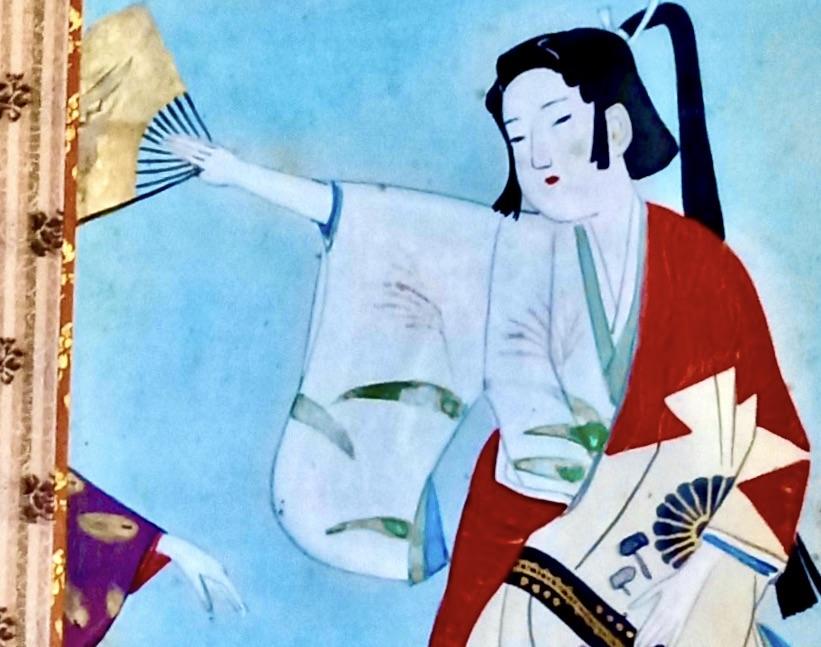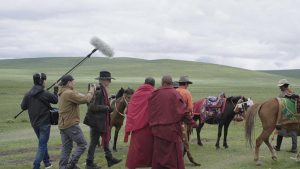Nearly 40 years ago, I purchased a scroll painting in Kyoto. It was from a neighbor of mine on the slopes of Yoshida Yama. My friend Saburo knew I collected paintings of dancers, and he had one he wanted to show me. He was a poor college grad studying meditation at Kurodani Temple near where I lived. The painting showed a boy dancing the Bon Odori—a late summer Buddhist celebratory dance to usher the ancestors back to their otherworldly abode.* The banks of the riversides teemed with dancing and families having fun. There were a number of things about the painting that gave it a unique appearance. His grandfather had obtained it along with a number of others around 1920. The scroll is signed and stamped. The painter is unknown. The painting is not in great condition, but it was a lesson I wanted to remember.
Not being as well-versed in traditional Japanese hairstyles, as I am now, I thought that the painting depicted a girl. The painting is, in fact, of a boy. Boys on the edge of adulthood are appreciated in traditional Japanese society for their fleeting fairness, in much the same way as cherry blossoms or falling leaves are poetically memorialized. Still today, beautifully dressed young men feature in fire festivals and Buddhist ceremonies in the mountains.
Saburo asked me to stay so he could talk me through the painting “It’s my favorite Zen painting of all that my grandfather left,“ he explained. He knew that saying so would grab my attention as I had just started studying Zen at a local monastery, was reading Kenneth Rexroth, and was open to understanding Zen. Saburo had studied Zen for many years. His life centered on his meditation practice. And he knew a lot about art from his family.
To call this painting of a festive dance “Zen” was puzzling to me because it was a not an austere ink landscape, or graceful, enigmatic calligraphy, and Saburo had some nice examples of both. The Bon Odori painting was a gorgeous, multi-patterned affair, decorative, like pretty things are. It didn’t seem a religious painting, but a secular one of a family dancing at Obon.
“It never lasts,” said Saburo.
“What never lasts?”
“The sun at high noon.”
I couldn’t help but notice the enormous rising Sun painted on the scroll. It was approaching high noon. I hadn’t thought to decode it as a symbol of transience. What does the Sun do but transit?
The painting is from the Japanese Taisho period, marking the reign of Emperor Taisho (1912–26). The world was complex following the Meiji era and marked by increased internationalism. Traditional Japanese artists were experimenting with Western artistic approaches such as in graphic design, in perspective, and depicting modern objects. This is a characteristic Taisho-era work, from the graphic cleverness to the patterned fabric framing.
The dancing boy in the painting might be shown in more traditional circumstances as a single figure, floating on an unblemished background. Instead, here we have a climbing sun and two other dancers, everybody moving clockwise. The boy is looking back. He is on a sky blue field. There’s no ground under anyone.
“Nothing fits,” said Saburo.
“It suggests dance; we can see which way they are moving.” I offered.
“There are two other dancers who don’t fit. The boy’s fan doesn’t fit. He barely fits.”
“Doesn’t sound very Zen to me, Saburo.”
“Tomorrow, the boy’s clothes won’t fit.”
The painting was becoming more interesting the more Saburo spoke. The boy remained innocent as a dancing boy would be. I asked Saburo: “The boy is innocent, there’s Zen in that?”
Saburo turned our attention once more to the painting.
“See what the boy is revealing by exposing the sleeve of his inner kimono? Like a butterfly wing, he has peeled the sleeve out of the red and white outer kimono. The waves of summer fall away. We see the design of sasa grass appearing—an autumn grass that only comes in September.”
“Fantastic! That is so Japanese!” I cheered. “Would the boy know that?”
Saburo answered, “His mother probably dressed him, and a barber did his hair.”
“It is Zen in piercing through the fleeting moment of the boy growing older—the inevitable progression of the seasons of life, even in a day, even in a moment?” I asked. Suddenly the sweet painting had a kind of urgency. Is there wisdom greater than the four seasons?
“Perhaps” answered Saburo. “It’s Zen because it is not only ‘right view’ but also spontaneity. Notice the point of view of the painter. It is straight on. Bon Odori is a circle dance. Someone dancing opposite the boy is looking directly at him in this perfect moment. What they are seeing is the cyclic nature of the universe at play. The dance is a bittersweet farewell to youth. The boy is as fair as the fleeting day. This painting is the epitome of the passing world.”
As the old poem says:
On the empty riverbanks
(Adapted from the work of the poet Kakinomoto no Hitomaru (c. 650–c. 709 CE))
The leaves of the sasa grass
Rustle in the wind.
I remember a dancer
Who is not here
* Bon Odori: A Dance with the Ancestors (BDG)
See more
Related features from BDG
Sagi Mai: Dance of the White Heron
Okina, an Endless Blessing from Long Ago
Noh Now
Rarified, Recondite, and Abstruse: Zeami’s Nine Stages
Hagoromo
Beauty and Sadness: Reflections on a Japanese Noh Play

















